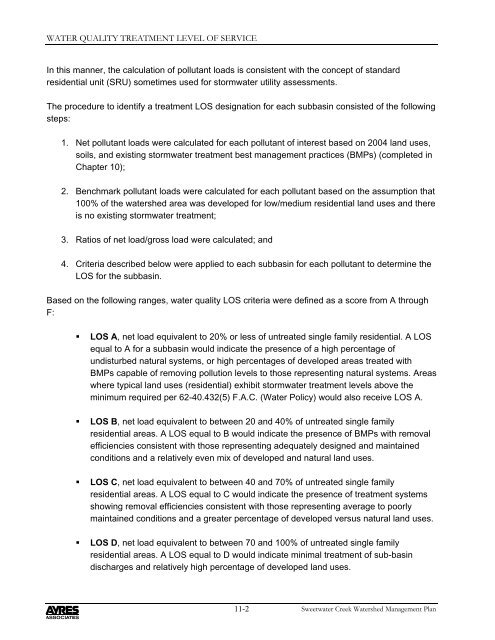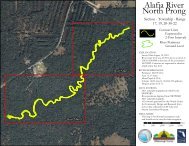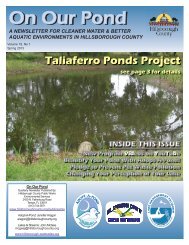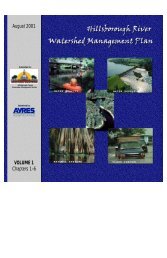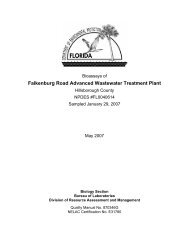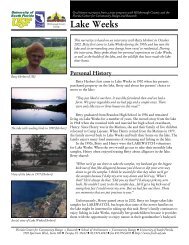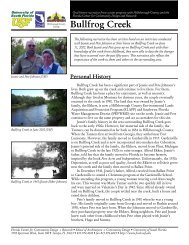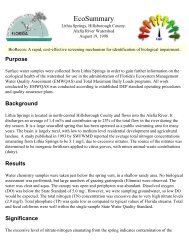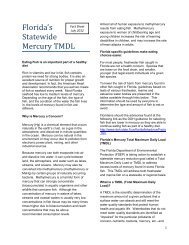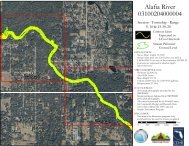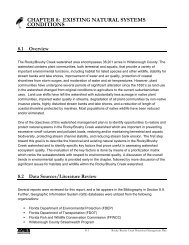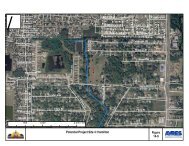Sweetwater Creek Watershed Mgmt. Plan 2007 Update--Part 2
Sweetwater Creek Watershed Mgmt. Plan 2007 Update--Part 2
Sweetwater Creek Watershed Mgmt. Plan 2007 Update--Part 2
Create successful ePaper yourself
Turn your PDF publications into a flip-book with our unique Google optimized e-Paper software.
WATER QUALITY TREATMENT LEVEL OF SERVICE<br />
In this manner, the calculation of pollutant loads is consistent with the concept of standard<br />
residential unit (SRU) sometimes used for stormwater utility assessments.<br />
The procedure to identify a treatment LOS designation for each subbasin consisted of the following<br />
steps:<br />
1. Net pollutant loads were calculated for each pollutant of interest based on 2004 land uses,<br />
soils, and existing stormwater treatment best management practices (BMPs) (completed in<br />
Chapter 10);<br />
2. Benchmark pollutant loads were calculated for each pollutant based on the assumption that<br />
100% of the watershed area was developed for low/medium residential land uses and there<br />
is no existing stormwater treatment;<br />
3. Ratios of net load/gross load were calculated; and<br />
4. Criteria described below were applied to each subbasin for each pollutant to determine the<br />
LOS for the subbasin.<br />
Based on the following ranges, water quality LOS criteria were defined as a score from A through<br />
F:<br />
• LOS A, net load equivalent to 20% or less of untreated single family residential. A LOS<br />
equal to A for a subbasin would indicate the presence of a high percentage of<br />
undisturbed natural systems, or high percentages of developed areas treated with<br />
BMPs capable of removing pollution levels to those representing natural systems. Areas<br />
where typical land uses (residential) exhibit stormwater treatment levels above the<br />
minimum required per 62-40.432(5) F.A.C. (Water Policy) would also receive LOS A.<br />
• LOS B, net load equivalent to between 20 and 40% of untreated single family<br />
residential areas. A LOS equal to B would indicate the presence of BMPs with removal<br />
efficiencies consistent with those representing adequately designed and maintained<br />
conditions and a relatively even mix of developed and natural land uses.<br />
• LOS C, net load equivalent to between 40 and 70% of untreated single family<br />
residential areas. A LOS equal to C would indicate the presence of treatment systems<br />
showing removal efficiencies consistent with those representing average to poorly<br />
maintained conditions and a greater percentage of developed versus natural land uses.<br />
• LOS D, net load equivalent to between 70 and 100% of untreated single family<br />
residential areas. A LOS equal to D would indicate minimal treatment of sub-basin<br />
discharges and relatively high percentage of developed land uses.<br />
11-2<br />
<strong>Sweetwater</strong> <strong>Creek</strong> <strong>Watershed</strong> Management <strong>Plan</strong>


